Poon Hill Trek
One of The Most Popular Treks In The Scenic Annapurna Region Of Western Nepal
Ghorepani, Annapurna Conservation Area, western Nepal. March 12, 2008
Nepal is one of the world’s premier hiking/trekking/tramping destinations. The Nepalese have always walked to get from point A to point B, mainly because in the hills of their Himalayan kingdom there is no other way – very few roads means the only way to get from village to village is to walk on well worn trails, trails that these days are shared by trekkers from all over the world. One could come to Nepal & walk for weeks on end, or one could come here and just walk for a day. For my Nepal trekking experience I settled on somewhere in between, but gravitated well towards the shorter time frame end of the scale. I opted for the Poon Hill Trek, one of Nepal’s most popular treks mainly because it offers a good balance – it provides, weather permitting, amazing mountain views without requiring 3 weeks of your time, not to mention energy. I completed the trek in March of 2008 with Pat, a very good friend of mine. The 3-day Poon Hill trekking adventure we shared was just one of the many highlights of an epic 4-month, we’re-in-no-particular-rush overland trip we embarked upon from Beijing, China to Ireland. What follows is a brief diary recap of our Poon Hill experience.
Poon Hill – A 7, 5, 4 or 3-Day Hike
We were told by every agent in Pokhara that we bothered to talk to about the Poon Hill Trek that it is typically a 5-7 day affair. We were skeptical, more than skeptical, & when querying this we were told that it could be done, at a push, in 4 days if we were “quick”.
“Quick. How about very quick?” we asked.
We’ve decided to try to do the supposed 5-7 day trek (4 days at a push) in 3 days. According to our guide, a very likable, as are all Nepalese, guy named Dill, it is possible to complete the trek in 3 days but to do so will require of us a big effort, upwards of 6-8 hours of strenuous, uphill walking a day.
“No problem Dill. You lead the way.”
So there you have it. Our trek will basically see us walking in a triangular pattern with two days of uphill walking followed by a day of downhill walking back to our starting position. So says Dill. Easy peasy.
The Off
We were on the road from Pokhara by 10 a.m. today, having picked up the permit that lets us walk for however many days in the national park that is the Annapurna Conservation Area. We didn’t have too much luck getting comfortable on the local bus that navigated the winding roads, slowly taking us to our drop-off point in a place called Brethanti.
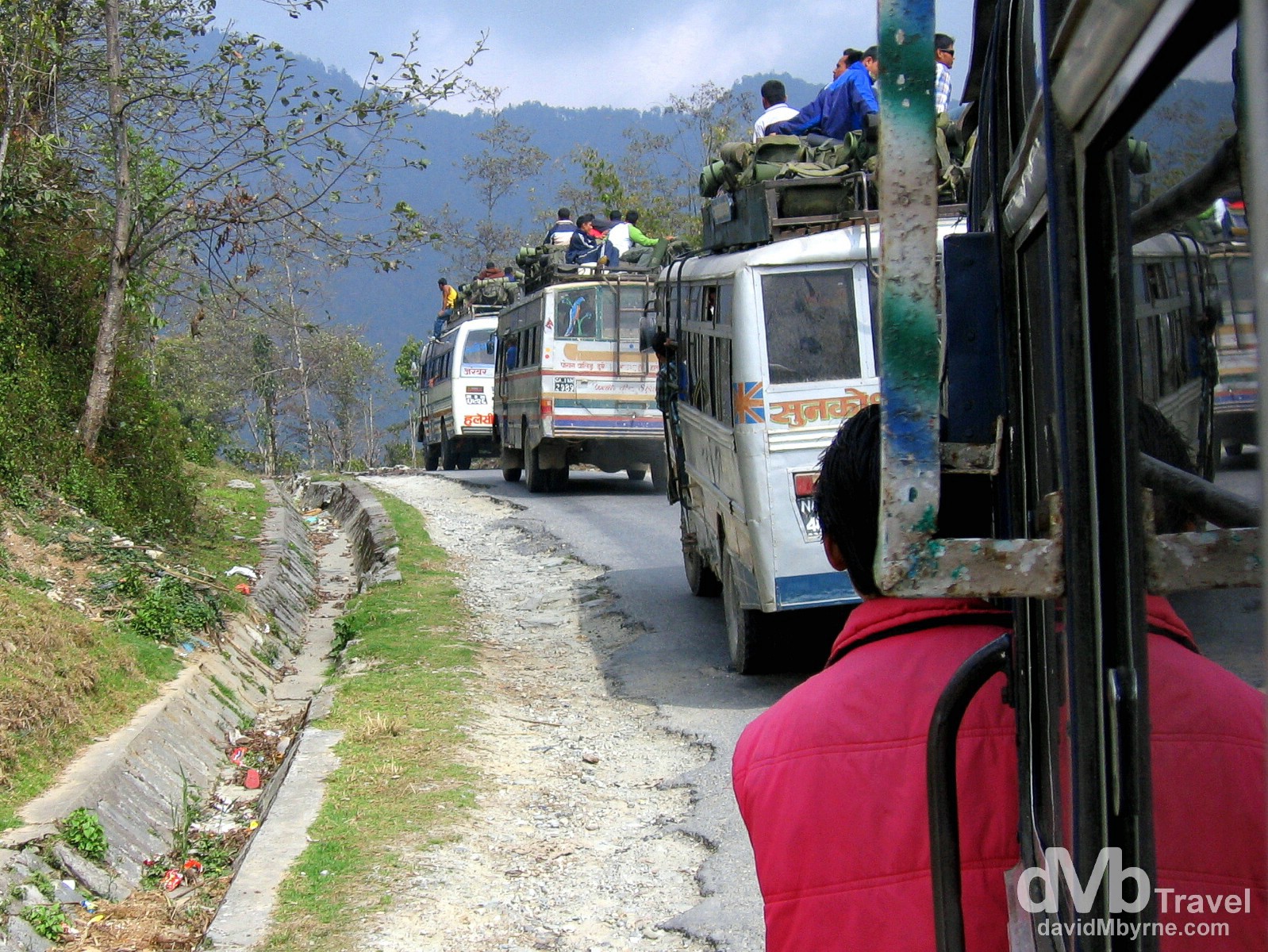
A bus convoy on the roads of western Nepal en route from Pokhara to Brethanti, the drop-off point for the Poon Hill Trek. Western Nepal. March 11, 2008
The bus, like all buses in Nepal, was not in a hurry. Far from it. The 35 kilometre trip took 90 bumpy, noisy minutes, meaning it was about noon today when we actually started walking. Trekking actually. Trekking in Nepal no less. Oh yeah.
The Trek || Day 1
It’s hard to make walking sound exciting so I’m not going to spend time here and now trying. All I’ll say is that we walked pretty much non-stop for 3 hours. The first 90 minutes were spent walking along a rocky valley floor and the second 90 minutes were spent walking up… and up… and up… and up, out of the same valley floor, until we reached our first overnight location of Ghandruk, a small village that clings to the steep sides of the valley and one that looks like at any moment it’s finally going to lose its fight with gravity & slide down the valley walls. To get here we had to pass through some quaint little villages. We also passed quite a few locals on the trail, trading “Namaste” (hello in Nepalese) greetings each and every time. But few, if any, of the locals were out for a relaxing stroll in the fresh mountain air enjoying, as we were, the smell of the rhododendrons (they are in bloom this time of year).
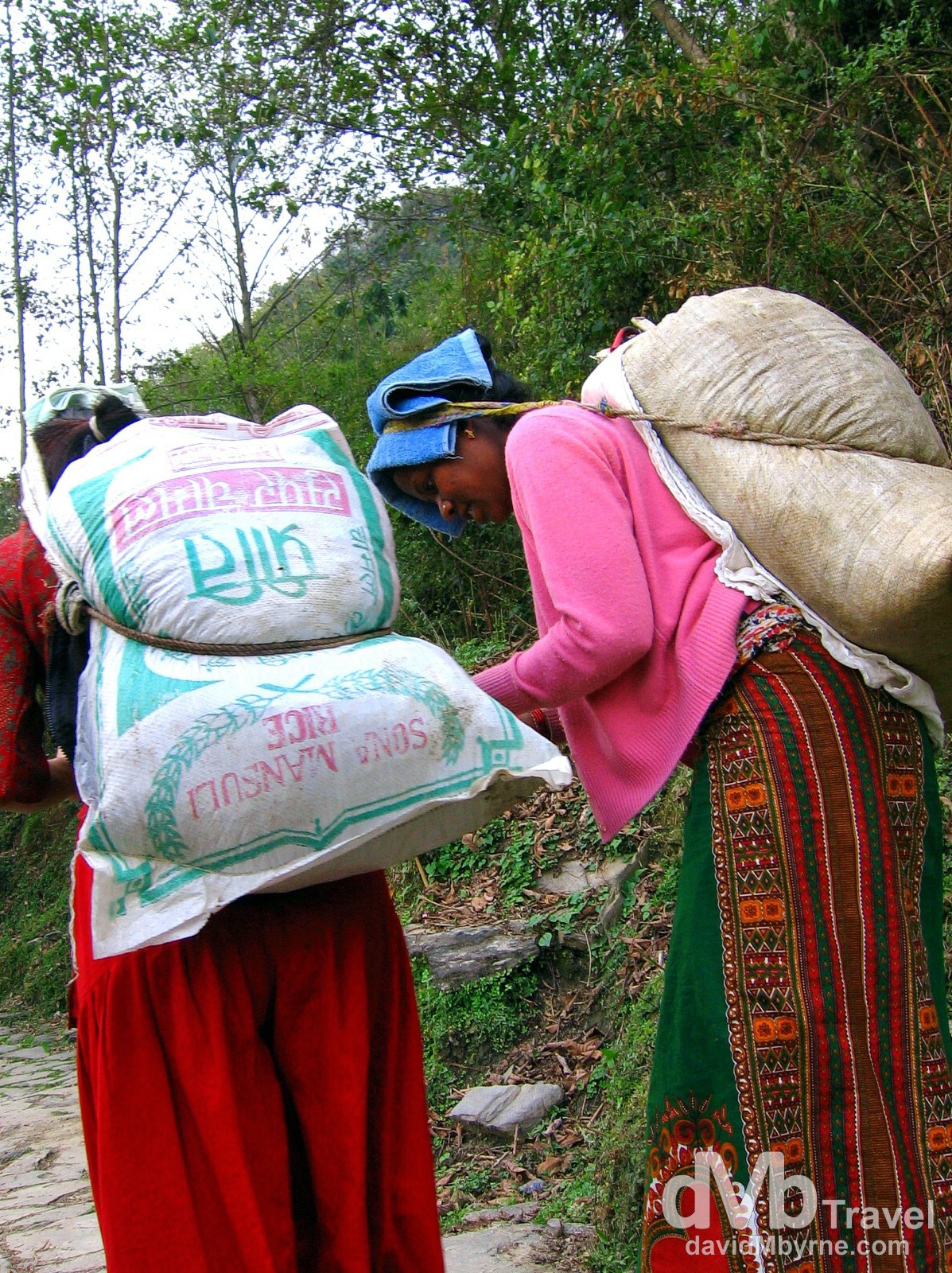
It’s a tough life on the trail from Birethanti to Ghandruk. These friendly locals stopped us & asked us for sweets. It was a rather bizarre request but what was even more bizarre was the fact that it was a request we could fulfil – we actually had sweets with us, glucose ones we had purchased a while ago in Tibet and sort of forgot to eat, but interestingly packed for this trek. It was like they knew. Bizarre indeed. On the trail from Birethanti to Ghandruk, Annapurna Conservation Area, western Nepal. March 10, 2008
As we walked we were awarded great views of far-off rice terraces, but no mountain views. Not yet. An ever-present haze was to blame for that. As we were walking along the valley floor Dill proclaimed that the mountains were “there,” pointing to the whiteness way in the distance.
“We’ll take your word for it Dill. We know you wouldn’t lie to us.”
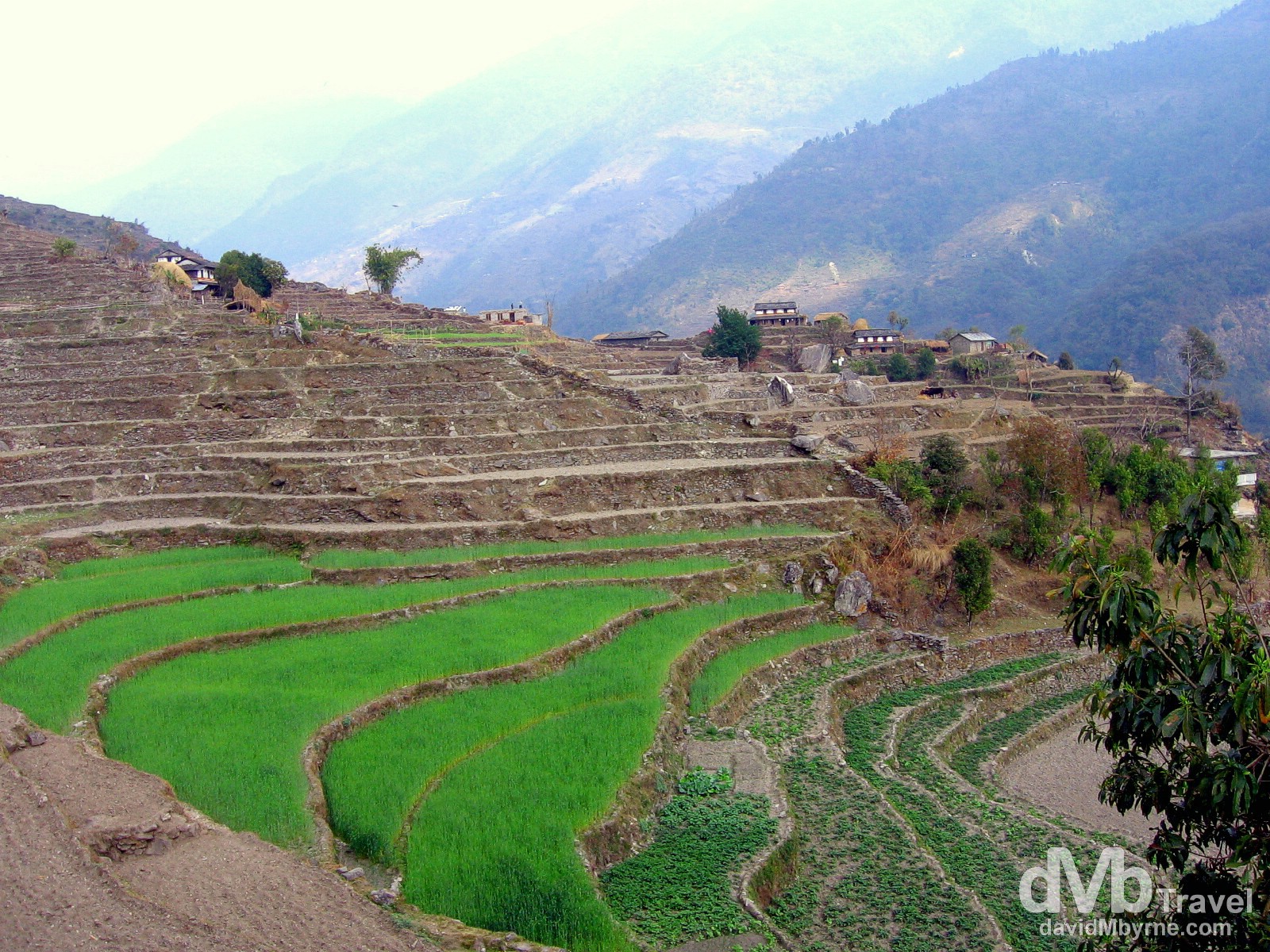
Rice terraces as seen from the Birethanti to Ghandruk trail. Annapurna Conservation Area, western Nepal. March 10, 2008.
Day 1 Observations
· Poor Dill
It took us 3 hours walking in total to get to Ghandruk, Dill having estimated earlier in the day that it would take us 5-6 (that was before he saw how fast we both like to walk).
“You see Dill, didn’t we say we were machines.”
He’ll never admit as much of course but we think he was a little perturbed by the pace we set, & even more perturbed that we maintained that pace for the whole 3 hours. Poor guy. And he calls himself Nepalese.
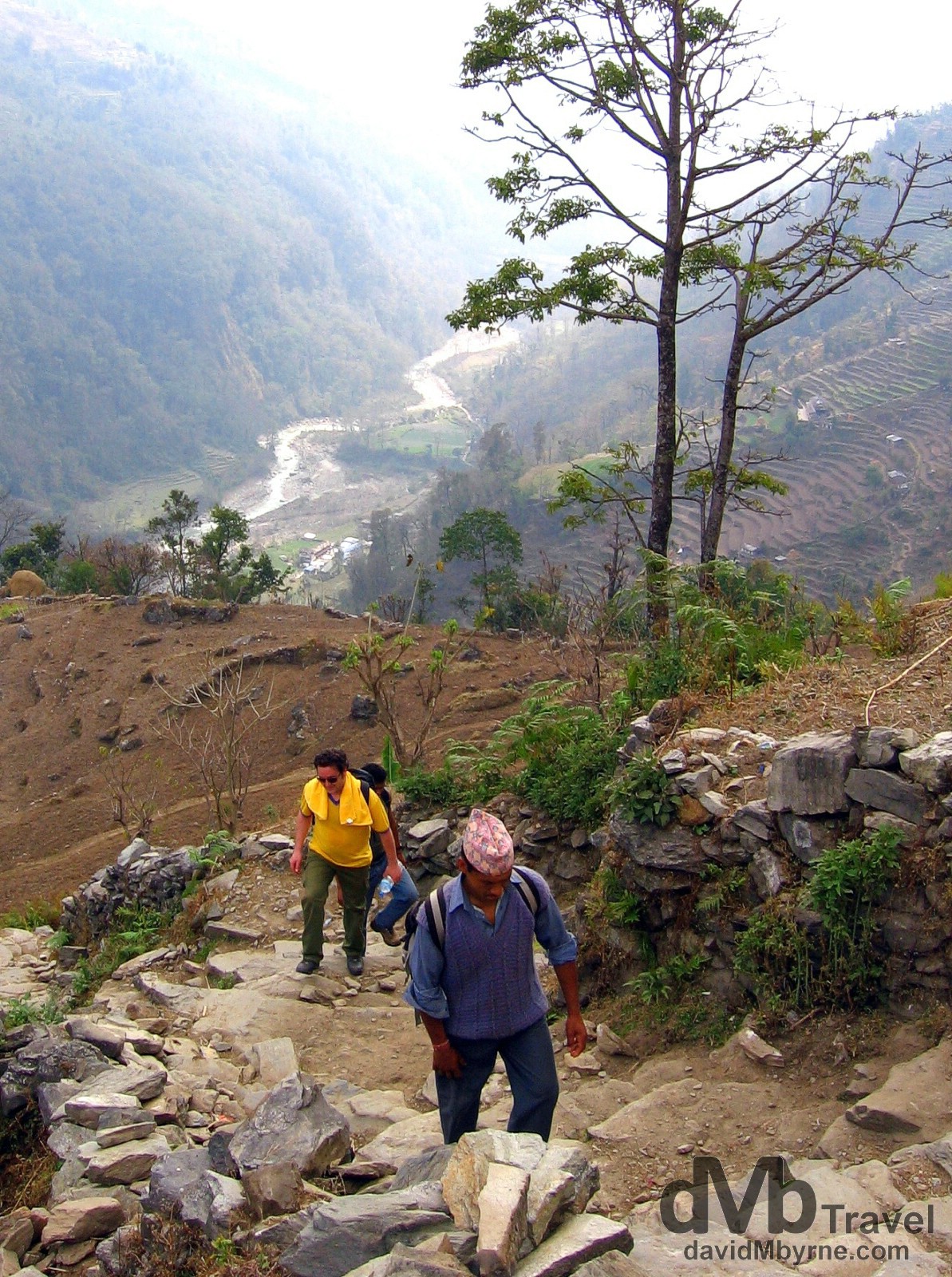
Pat (yellow t-shirt) on the march up, up, up, with Dill right behind. The valley we spent the first 90 minutes walking along today can be seen in the background, as can the haze obscuring our view of the mountains at the other end of the valley. On the trail from Birethanti to Ghandruk, Annapurna Conservation Area, western Nepal. March 10, 2008
· Nothing To Do
Maybe you shouldn’t walk as fast as we do. There’s no rush because there isn’t really much to do in these overnight villages once you actually arrive. One of the disadvantages of getting here early (we arrived in Ghandruk at 3 p.m.) was that unless you bring some entertainment with you (we were packing light for the trek and thus didn’t even bring a book with us), or are the sort of person who can sit still for hours doing absolutely nothing, then you’re gonna get bored fast. I for one got restless very soon after we arrived. Taking a stroll around the village didn’t do much to appease my restlessness, nor did the fact that my MP3 player was almost out of battery power (a consequence of Nepal’s erratic power grid). Pat had no such problems. He could quite easily sit still for hours on end, happy with his thoughts. He started telling me that the fact that I get restless so easily makes me a good traveller. I couldn’t quite figure out what he meant. He explained his reasoning but to be honest it was lost on me.
· Solar Powered
Ghandruk, like all villages in these parts, is electrically challenged so we had a solar powered shower today not long after we arrived. Warm? Not really. Cold? Not really. It was somewhere in between. Solar powered or not, it was great to get our sweaty clothes off our backs and put on a fresh set so we could sit on the guesthouse veranda sipping tea & taking in the views of the nothingness before us.
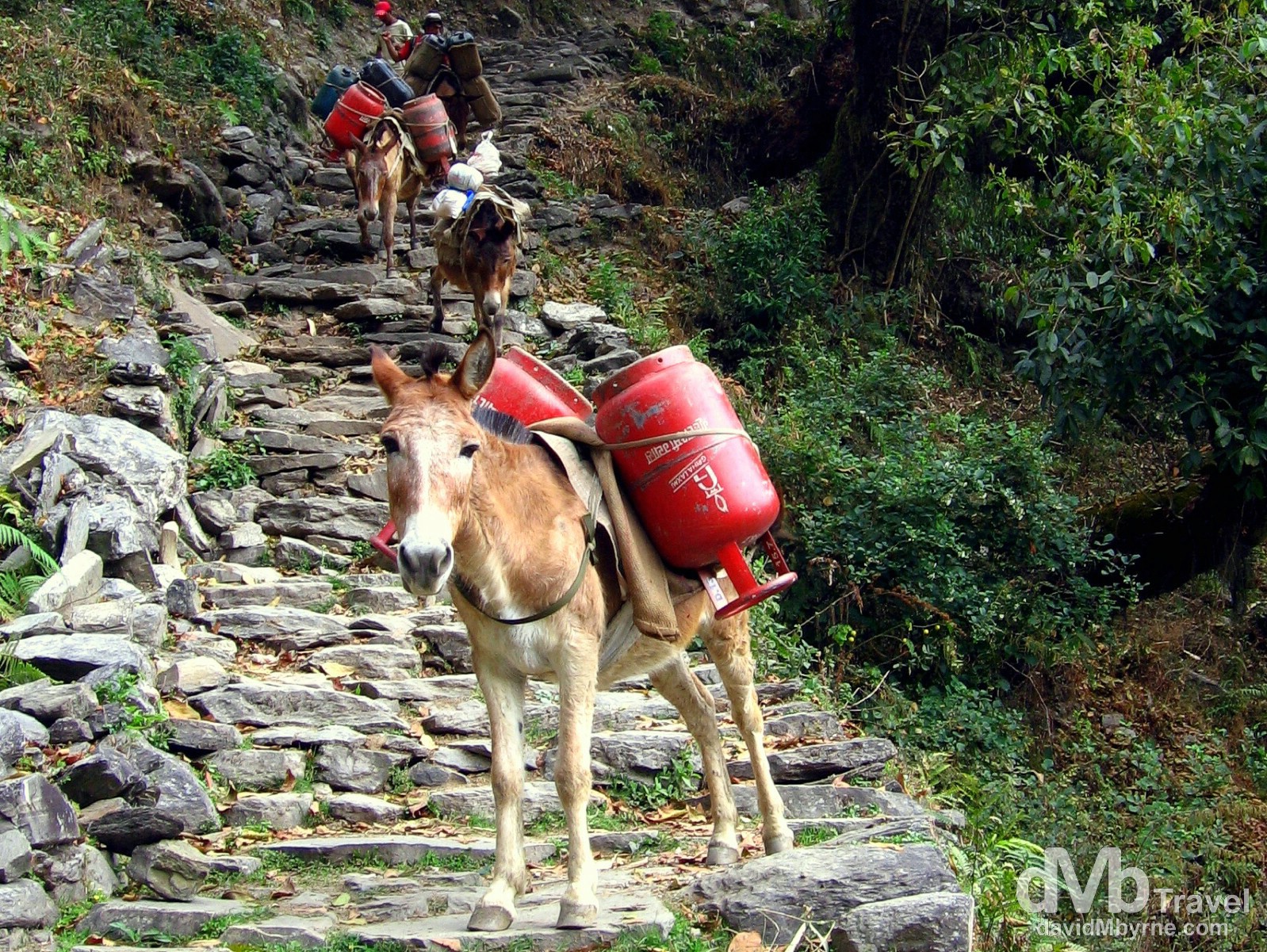
It wasn’t just humans we shared the trek trail with today. A common sight are donkey convoys transporting goods (everything from gas bottles, beer, water, cement and food) up the mountains. On the trail from Birethanti to Ghandruk, Annapurna Conservation Area, western Nepal. March 10, 2008
· Once You’ve Popped
We treated ourselves to a tube of Pringles today. The green ones – sour cream & onion. Yummy. A little piece of heaven, very close to it.
· Meat & 2 Veg. But no Beer
We gorged on dinner tonight. The menu in the Trekkers Inn Guesthouse here in Ghandruk is a weird one.
“What comes with the roast chicken?” we asked the lady taking our order.
“Just roast chicken,” she replied.
“No veg… chips?” we asked.
“These extra,” she informed us.
Pat had convinced me that we have to have a typical Irish meat-&-2-veg meal – it’ll be good for the energy levels he claimed. So based on the menu presented to us we ended up ordering chicken, mixed veg & potatoes, thinking they would all come on the same plate. They didn’t and we ended up with three separate meals. Each. The table wasn’t big enough for all the dishes. Dill almost collapsed at the sight of the dishes coming out of the kitchen, no doubt thinking we were abusing the fact that all meals and accommodation are included in the cost of the trek. By the way, we also ordered dessert. That was Pat’s idea too.
· St. Paddy’s Day in Varanasi
The following happened before I got restless. We were sitting in silence, lost in our respective thoughts, on the veranda of the guesthouse. We had just polished off a pot of tea, our feet were up & we were staring into the white nothingness, the nothingness obscuring our view of the mountains we’ve been assured are towering over us, not to mention the valley we were sitting in. It was then I realised the significance to today’s date.
“Here Lad, do you know what date it is today?” I asked.
“No idea, why?”
“March 10th.”
“Yeah, and?”
“March 10th. That means Paddy’s Day is in a week”, now making sense to Pat who was sufficiently lost up until this point of the conversation.
“Oh yeah,” he exclaimed before asking where we were going to be for St. Paddy’s Day.
“All going to plan Varanasi, India, I reckon.”
“Varanasi. Umm. You’ve been there before, yeah? Do they have any Irish bars?”
“An Irish bar in Varanasi? I dunno Lad, but I doubt it very much. Sure we don’t need an Irish bar pass a Paddy’s Day, do we?”
“Suppose not, but it would be nice. Varanasi for St. Paddy’s Day. Who’d have guessed that.”
I had a rather unusual alarm call this morning.
“Dave! I see a mountain” were the first words I heard as I was awoken from my slumber at 7 a.m. by an excited Pat. He was like child on Christmas morning.
“Make that two mountains… two big mountains,” he continued, having paid another split-second visit to the balcony outside our room to take another glance up the valley.
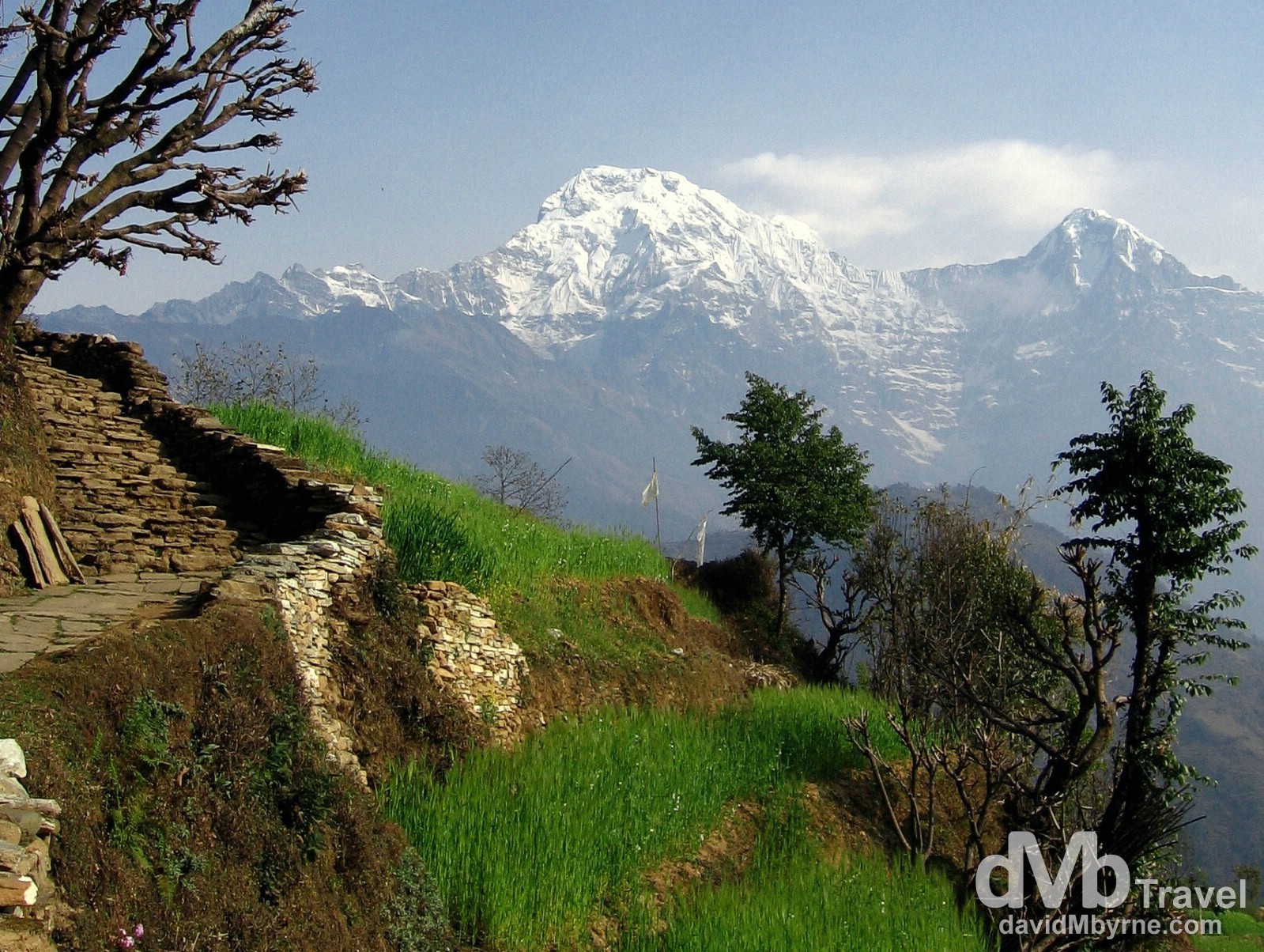
The peak of Annapurna South (7,219 metres / 24,000 ft) as seen from the village of Ghandruk in the Annapurna Conservation Area, western Nepal. March 11, 2008
Sure enough there they were. Two of the peaks we came here to see but didn’t see at all yesterday, even though we spent 3 hours facing them as we walked towards Ghandruk. This is more like it we thought. After a hearty breakfast (we’re sure the guesthouse was trying to kill us – death by gorging) and a French shower (a spray of deodorant) we were on our way again, spirits high.
“How many hours walking today Dill?” we asked as we set off at 8:30 a.m., the glorious 7,219-metre (24,000 ft) peak of Annapurna South staring right down on us as we walked through wooded terrain with rocks and wet leaves underfoot, a distinct change to the walking conditions of yesterday.
“6 to 7,” he answered.
“Grand so, we’ll do it in 5,” we estimated.
And we did. 5 hours later we were walking into our next overnight village, Ghorepani, right at the base of Poon Hill itself. It wasn’t an easy 5 hours. Far from it. We went up, up, up, down, down, down, up, up, up and finally down, down, down, again – yes, strangely enough we seemed to walk down into Ghorepani. The up, up, ups weren’t easy, nor were the down, down, downs, but that probably had something to do with, once again, our pace. By mid-morning the mist that had yesterday obscured our views of the mountains, the ones we could now say for sure were there, had returned and we were once again staring into white nothingness, white nothingness we actually descended through as we approached Ghorepani village. Having arrived in Ghorepani at 2 p.m. we found we had even more time on our hands in this village than we did the previous afternoon in Ghandruk. It was probably a good thing then that we found a book shop. Another highlight of the village was the fact that the guesthouse we stayed at, although unable to boast of having electricity, had hot apple pie and custard. What a treat that was, a huge step up from the Pringles we savored 24 hours earlier. The rest of the afternoon and this evening was taken up with reading and eating, but not drinking. We’ll be in bed again early tonight and we’ll be setting the alarm for a 5am wake-up. Poon Hill overlooks the village and we’ll be doing the requisite early morning climb tomorrow to see sunrise over the Annapurnas, the Himalayan mountain range that dominates this part of Nepal. A Poon Hill trekker has gotta do what a Poon Hill trekker has gotta do We’re holding out hope for good views although Dill isn’t too optimistic. There’s gotta be some reward for the two days of walking, not to mention the 5 a.m. wake up.
Thank You Whoever
Thank you God. Thank you Allah. Thank you Vishnu. Thank you Buddha. Thank you whatever god, or gods, have reign over this part of the world. We now know somebody listened to our prayers last night, prayers that asked for clear mountain views this morning. Someone obviously decided that we’d had enough of seeing misty, white nothingness and that we’d probably suffered enough in getting here, that we’d suffered enough to cut us a break on this, the last day of our 3-day Poon Hill trek. Pat & I were in agreement while standing atop of Poon Hill (3,200 meters / 10,500 ft) at 6 a.m. this morning that there was indeed a god and that what we were feasting our eyes on at that exact moment made all the effort worthwhile – the two days of sweat-inducing, ankle-twisting walking, the 2 days of looking at mist when we knew it was hiding something so much better, the 2 days without a beer, 2 days without electricity, 2 days of solar powered showers, the combined 10 hours we spent in buses (from Kathmandu & Pokhara) to get to the starting point of the trek, and finally the mind-your-step obstacle course we completed when leaving our guesthouse and walking up Poon Hill in the pitch dark at 5:30 a.m. this morning. Yes, that’s what we had to endure to get here but it was all worth it.

A panoramic picture of early sunrise on the face of the peak Dhaulagiri (8,167 metres / 26,795 ft) as seen from Poon Hill. The rising sun first struck the face of Annapurna South (7,219 metres / 24,000 ft) to our right, a peak Pat nicknamed ‘Ann-Purna Kova’ due, he says, to its slender appearance (I think he’s missing his girlfriend). Once the suns rays had risen over Annapurna South the first light of the day hit the peak of Dhaulagiri, sitting in all its glory to our left. Dhaulagiri, although not part of the Annapurna range, is the highest peak in the region & the 7th highest mountain on earth, and watching the light slowly creep down the face of the mountain was a magical experience. Poon Hill, Annapurna Conservation Area, Nepal. March 12, 2008
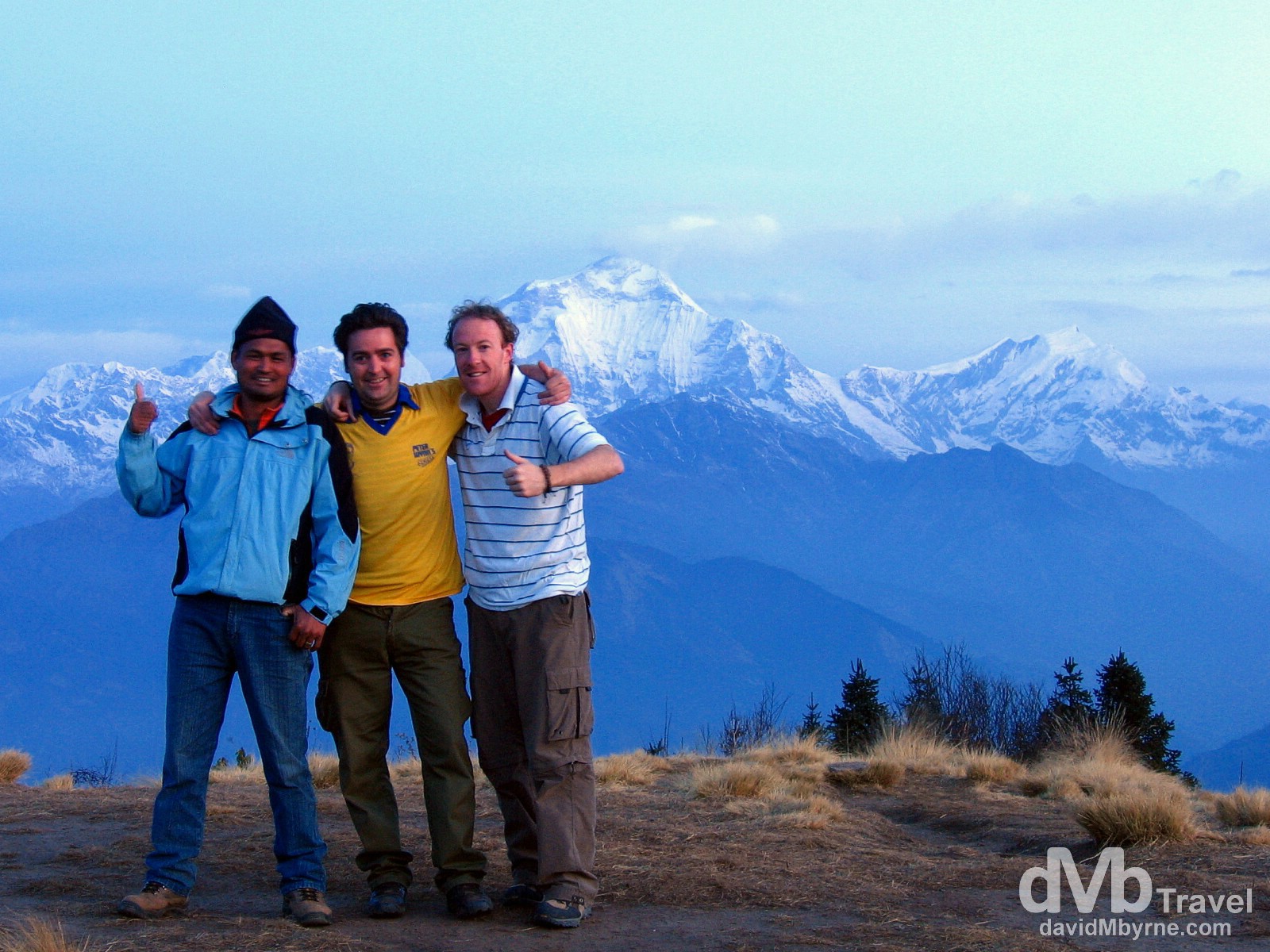
L-R: Dill, Pat and I on Poon Hill with Dhaulagiri in the background prior to sunrise. If we look cold it’s because we were. Well, Pat and I were but Dill was, and as one might expect, better prepared for the temperatures. Poon Hill, Annapurna Conservation Area, western Nepal. March 12, 2008.
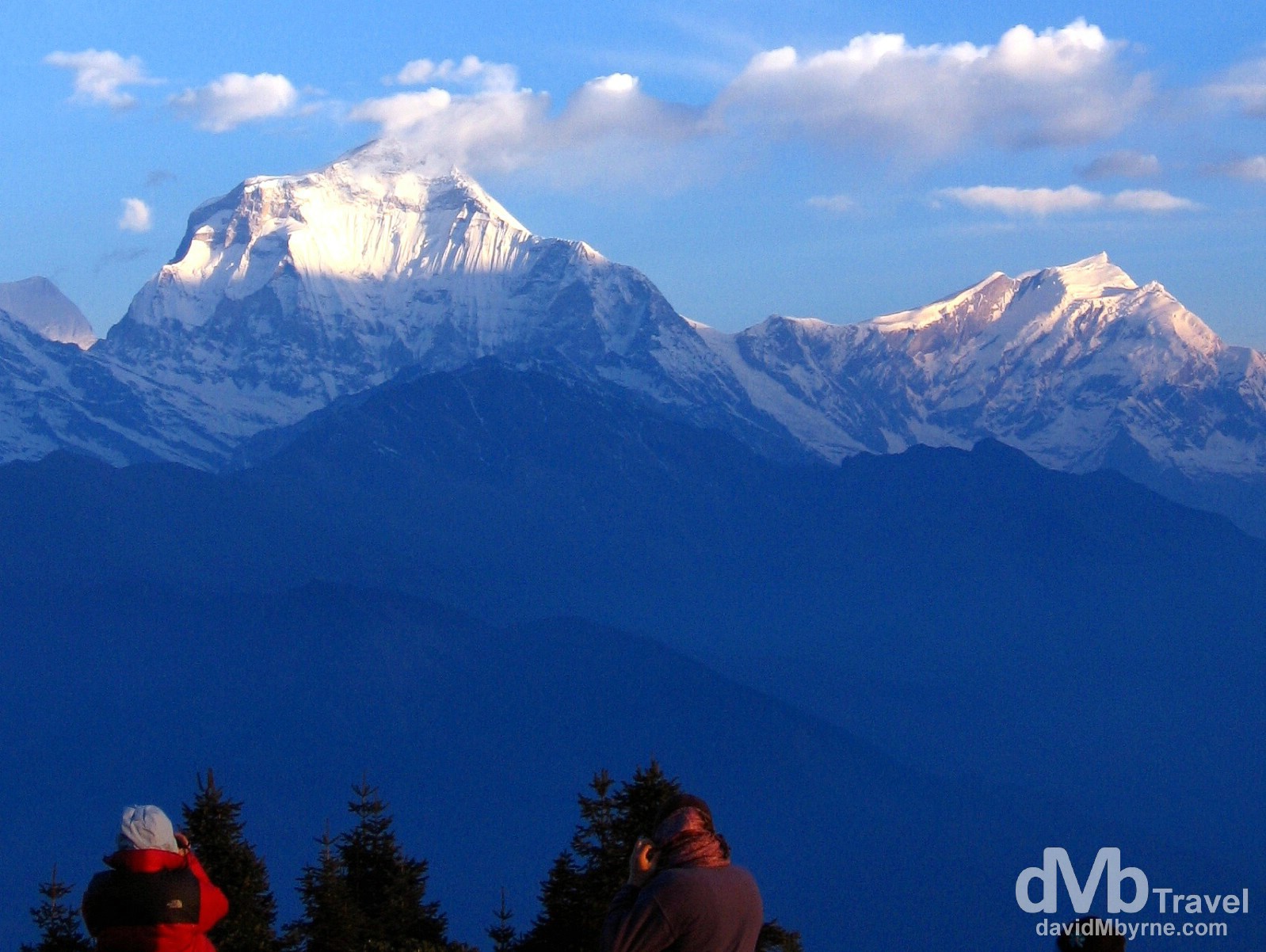
Mountain-watching, jacket-wearing tourists sharing the views of Dhaulagiri as early morning sunrise creeps up the face of the mountain as seen from Poon Hill, Annapurna Conservation Area, western Nepal. March 12, 2008
We spent an hour or so on Poon Hill with numerous other camera-toting tourists, sitting there as the sun rose from our right slowly illuminating the peaks to our left. It was a spectacular, unobstructed sight – the full beauty of a small, albeit grand, section of the Himalayas spread out before us. The absence of sunlight at 3,200 metres meant it was cold up there, temperatures we, with our trekking uniform of t-shirts and light sweater, were ill-equipped for. But that didn’t matter. Didn’t matter in the slightest. We kept moving, cursing all the warm, winter-jacket wearing tourists sharing the views with us and when we had had our fill of views and had taken all the pictures we wanted (miraculously our digital camera batteries held out for 3 days without needing a recharge) we headed back down to Ghorepani where we had breakfast before starting the descent. Oh the descent.
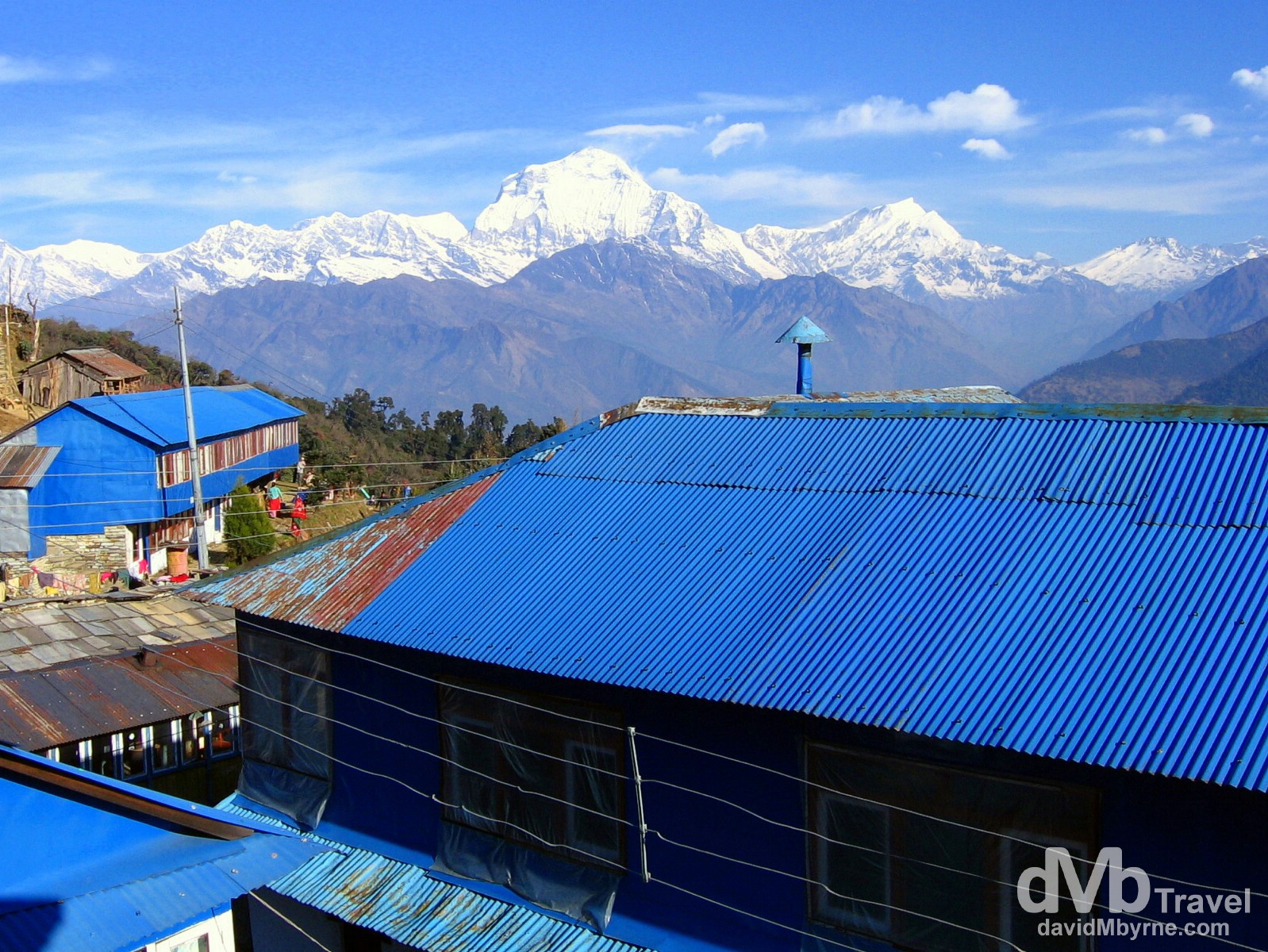
The distinctive blue galvanised roofs of the buildings of Ghorepani village. The village sits 450 metres (1,500 ft) below Poon Hill and the sight of the 8,167 metre (26,795ft) Dhaulagiri behind the village makes for a spectacular backdrop. Annapurna Conservation Area, western Nepal. March 12, 2008.
Down. Down. Down.
The old adage that what goes up must come down holds true for trekking in Nepal and we were well aware during our two days of walking uphill that on the third day that it would be a different story and that we’d have to walk back down. We weren’t retracing our steps from days 1 & 2 but we’d still have to reverse our two day altitude gain of some 1,900 metres (6,300 ft) in one day. That’s quite a drop, a drop our knees now know all about. We pounded them – our knees – as we walked down, down, down the valley wall we had to reach the bottom of. And when we thought we were finished walking down, down, down, we’d walk down, down, down all over again. It was, for two solid hours, relentless and the only solace we could take from the punishment we were inflicting on ourselves was that we passed dozens of other trekkers making the slow, painful ascent up the same flights of steps we were descending (we’d much rather be going down). But the down, down, down was only the half of our day 3 walk today. When we finally reached the valley floor we had another 2 hours of walking ahead of us to get back to where we were to catch the bus back to Pokhara. It was flat walking and it shouldn’t have been a problem, but it was probably the longest 2 hours of walking we did over the whole 3 days. Maybe it was the previous two days of walking catching up on us. Maybe it was the pace. Maybe it was the 2 hours of downhill stomping we had just completed. Maybe it was all three. Whatever it was by the time we got to the valley floor neither of us were quite ready for the walk that lay ahead and had we been able to charter a few donkeys to take us the rest of the way then it would have been money well spent. But we soldiered on and eventually made it back to the starting point of the trek, albeit not in as good a physical shape as we were at the same point 2 days earlier – bright eyed and bushy tailed we were back then, tired, sweaty and longing for a shower (& a beer) we were today. After a quick lunch and 2 hours spent on a crammed local bus sandwiched between two local Nepalese we were back in Pokhara. Time to relax and time to recover as we waited for the onset of the real hurt in the morning. It’s unavoidable.
